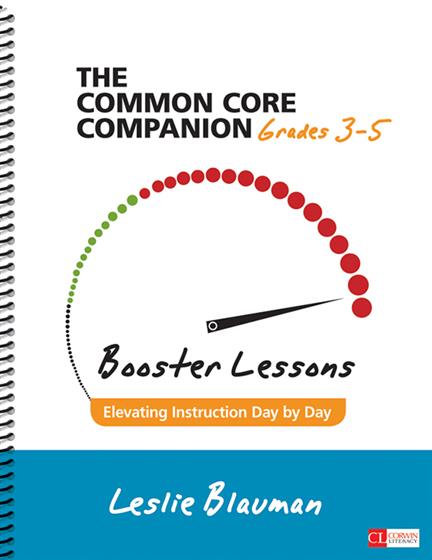Introduction
LESSON SEQUENCE 1: Integrating Opinion Writing With Evaluating Argument
What Teachers Guide Across the Week
What Students Do Across the Week
Booster Reading Lesson 1: Understanding Point of View
Adapting This Lesson for Other Text Types: Informational
Companion Writing Lesson 1: Launching Opinion and Persuasive Writing
Snapshot of a Turn-and-Talk Peer Conference on POV
Booster Reading Lesson 2: Co-Constructing and Close Reading
Companion Writing Lesson 2: Determine Structure and Essential Elements
Language Connections: Formal Versus Informal English
Booster Reading Lesson 3: Reading and Annotating Fairy Tales
Companion Writing Lesson 3: Planning and Drafting
Booster Reading Lesson 4: Compare/Contrast Writing
Companion Writing Lesson 4: Revision Focus on Transition Words
Booster Reading Lesson 5: Complete Compare/Contrast Piece
Companion Writing Lesson 5: Edit and Finalize Piece
Third-Grade Adaptation
Fifth-Grade Adaptation
NEXT INSTRUCTIONAL STEPS
What Do I See? A Student Sample of Persuasive Writing
What Do I See? A Student Sample of Compare and Contrast
Authentic Assessment: Student Reflection and Evaluation
Peer Power: How to Use Student Work as Mentor Texts
If/Then Chart
Mentor Texts
Unit Planning: How to Build Out Three Weeks
LESSON SEQUENCE 2: Integrating Reading Craft and Structure With Opinion Writing
What Teachers Guide Across the Week
What Students Do Across the Week
Booster Reading Lesson 1: Explaining How an Author Uses Reasons and Evidence in Informational Text
Companion Writing Lesson 1: Expressing an Opinion in Response to Text
Booster Reading Lesson 2: Examining How Text Features Help With Main Idea and Evidence
Companion Writing Lesson 2: Modeling Opinion Writing
Language Connections: Determine or Clarify the Meaning of Unknown Words
Booster Reading Lesson 3: Using Essential Questions to Dig Deeper
Companion Writing Lesson 3: Launching Opinion Writing
Booster Reading Lesson 4: Moving to Independence
Companion Writing Lesson 4: Working Through the Writing Process
Booster Reading Lesson 5: Assessing Our Learning
Companion Writing Lesson 5: Wrapping Up the Writing
Snapshot of How to Move From a Written Opinion Piece to a Speech
Third-Grade Adaptation
Fourth-Grade Adaptation
NEXT INSTRUCTIONAL STEPS
What Do I See? A Student Sample of Response to Reading
What Do I See? A Student Sample of Response to Reading
Authentic Assessment: Student Reflection and Evaluation
Peer Power: How to Use Student Work as Mentor Texts
If/Then Chart
Mentor Texts
Unit Planning: How to Build Out Three Weeks
LESSON SEQUENCE 3: Integrating Narrative Writing With Craft and Structure
What Teachers Guide Across the Week
What Students Do Across the Week
Booster Reading Lesson 1: Elements of Myths
Companion Writing Lesson 1: Starting to Envision an Original Myth
Adapting This Lesson for Other Text Types: Informational
Booster Reading Lesson 2: Co-Constructing a Summary and Independent Reading
Companion Writing Lesson 2: Planning a Myth
Booster Reading Lesson 3: Mini-Book Clubs
Companion Writing Lesson 3: Adding Character Description and Dialogue
Language Connections: Eavesdropping on a Book Club Conversation
Booster Reading Lesson 4: Looking at Language
Companion Writing Lesson 4: Rich Language Equals Rich Writing
Booster Reading Lesson 5: Wrapping Up and Assessment
Companion Writing Lesson 5: Finalizing the Myths
Langage Connections: Reading With Fluency
Third-Grade Adaptation
Fifth-Grade Adaptation
NEXT INSTRUCTIONAL STEPS
What Do I See? A Student Response to Literary Elements
What Do I See? A Student Sample of an Original Myth
Authentic Assessment: Student Reflection and Evaluation
Peer Power: How to Use Student Work as Mentor Texts
If/Then Chart
Mentor Texts
Unit Planning: How to Build Out Three Weeks
LESSON SEQUENCE 4: Integrating Explanatory Text Writing With Reading for Key Ideas
What Teachers Guide Across the Week
What Students Do Across the Week
Booster Writing Lesson 1: Informative/Explanatory Text Makes the World Go 'Round
Companion Reading Lesson 1: Noticing Text Features
Adapting This Lesson for Other Text Types: Literature
Booster Writing Lesson 2: Grouping by Headings
Companion Reading Lesson 2: How Authors Use Headings
Booster Writing Lesson 3: Sequencing Information
Companion Reading Lesson 3: Close Reading a Text and Visuals
Language Connections: Vocabulary
Booster Writing Lesson 4: Vocabulary and Elaboration
Companion Reading Lesson 4: Assessing Understanding With Annotating and Summarizing Text
Booster Writing Lesson 5: Presenting the “All About” Pieces
Companion Reading Lesson 5: Presenting the “All About” Pieces
Snapshot of a Presentation
Fourth-Grade Adaptation
Fifth-Grade Adaptation
NEXT INSTRUCTIONAL STEPS
What Do I See? A Student Sample of Informative Text
What Do I See? A Student Sample of a Topic Written in Two Different Formats
Authentic Assessment: Student Reflection and Evaluation
Peer Power: How to Use Student Work as Mentor Texts
If/Then Chart
Mentor Texts
Unit Planning: How to Build Out Three Weeks
LESSON SEQUENCE 5: Integrating Research With Presentation
What Teachers Guide Across the Week
What Students Do Across the Week
Booster Writing Lesson 1: Introducing Research and Questions
Companion Reading Lesson 1: Evaluating Print and Digital Content
Adapting This Lesson for Other Text Types: Literature
Booster Writing Lesson 2: Determining Importance and Note-Taking
Companion Reading Lesson 2: Becoming a Media-Savvy, Critical Reader
Snapshot of Student Collaboration
Language Connections: Words in Their Best Order
Booster Writing Lesson 3: A Focus on Note-Taking
Companion Reading Lesson 3: Analyzing Notes
Booster Writing Lesson 4: Drafting
Companion Reading Lesson 4: Re-Reading and Refining Drafts
Booster Writing Lesson 5: Putting It All Together
Companion Reading Lesson 5: Compelling Conclusions
Third-Grade Adaptation
Fourth-Grade Adaptation
NEXT INSTRUCTIONAL STEPS
What Do I See? A Student Sample of a Nonfiction Article
What Do I See? A Student Sample of a Nonfiction Research Piece
Authentic Assessment: Student Reflection and Evaluation
Peer Power: How to Use Student Work as Mentor Texts
If/Then Chart
Mentor Texts
Unit Planning: How to Build Out Three Weeks
References



